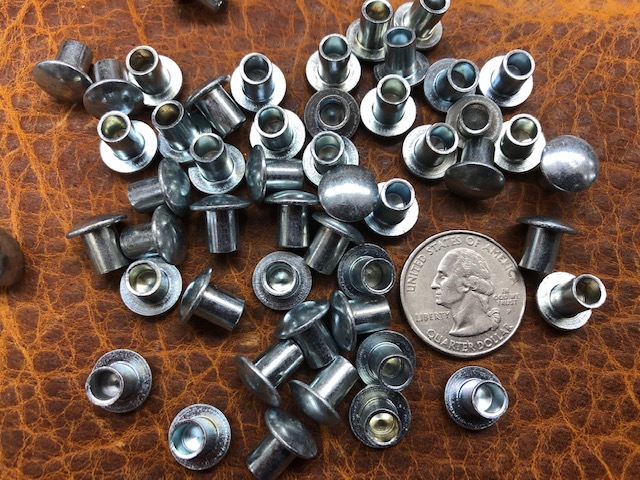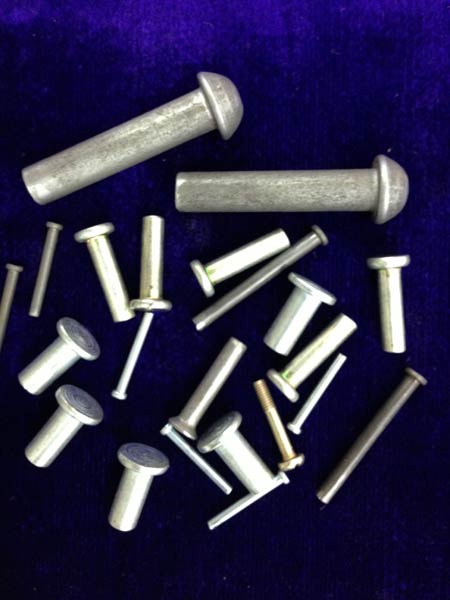

In this imaginary riveting demo, I am using 14 gauge copper wire. Preferably four of them.ĭetermine what gauge of wire to use. Better yet, use a drill press or a Dremel drill press.Ī nail set, center punch or an automatic spring punch.Ĭlamps – small, yet strong clamps – like these red tipped ones. If it doesn’t drill easily, perhaps it’s time to get a new drill bit. Try not to rotate the drill bit too much as that will make the hole larger. When drilling, hold the flex shaft perpendicular to the metal.

If you are unsure, make a test hole in scrap metal and then insert the wire. To learn about hand drills check out this great article called “Hand powered drilling tools and machines”by Kris de Decker, the founder of Low-tech Magazine.ĭrill bits – These you want to match to the size of wire that you are using for your rivet. Someway to spin those drill bits – Either a flex shaft, a Dremel or a drill (manual, battery or electric). You can use a bench block, an iron (without steam holes) held upside down in a vice, a railroad tie, or an anvil -whatever you have or want. If you hammer your rivet on wood, you’ll reduce the amount of force the rivet receives – as the wood will “give” under your blows – and you’ll not only dent your wood surface (probably your desk) but you’ll make a lovely bowl shape in your metal. Steel Surface – This is to hammer the rivet on. This hammer has a wedge shaped edge on one side. Another type of hammer used for riveting is called a Riveting or Cross peen hammer. What is means is that one end has a hemispherical or ball-shaped end. Hammers – Ball peen, or ball pein or ball pane – three names for the same thing. Copper, brass, steel, sterling, fine silver, bronze, whatever… Round Wire – gauges (B&S Gauge/AWG) 12, 14, 16 or 18 (although any gauge will do – these are just the easiest to rivet with). OR, any two random things that you want to join together. Metal – any kind that you want to bond together. Please see my website for a written tutorial on tube, invisible and decorative rivets under Techniques ( UNDER CONSTRUCTION) Materials and Tools for Creating Rivets We’ve just created four videos on riveting: Basic Rivets, Tube Rivets, Invisible or Flush Rivets and Decorative Rivets. The above necklace uses basic rivets to hold the image between the 2 sheets of copper and ball rivets to attach the bail to. Some rivets can hold pieces immobile while others can be designed so that there is mobility. the tail – which is at the opposite end of the head! Makes sense to me. They can be a place to hang a jump ring or tie a ribbon.

They can disguise themselves as screws or a stone setting. They can be decorative or blind (invisible). Rivets can be used on almost any material and have any random stuff in the middle. Although, Rivets are a great way to attach metal to metal and attach any thing in between them. I often have to true up my edges because of this shift. Often when riveting, the metal shifts a hair and if you pre-drilled your holes, they will no longer line up. When making more than one rivet, make one first, then the second, then the third, etc.

Pull the paper/metal out after riveting, or soak as stated above. You want the rivet to pull out easily but, not leave such a big space that the rivet isn’t hammered evenly. Make sure that the slot is not too wide or too narrow. To help with removal, cut a slot that runs from the hole, in the paper or metal, to the outside edge. After completing the rivet, either rip the cardboard out or soak it until it becomes soft and then tear it out. Put the rivet through the top piece of metal, then through the cardboard and finally, through the bottom piece of metal. Drill a hole in the cardboard and put it between the rivet heads (top and bottom) and the base metal (top and bottom – if a lot of movement is required). You can also use thin metal like brass foil instead. To create a rivet that allows pieces to move, use a thin piece of cardboard, like the type used in food packaging.


 0 kommentar(er)
0 kommentar(er)
